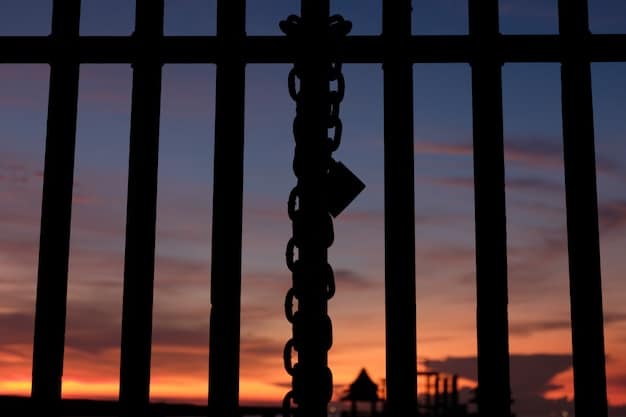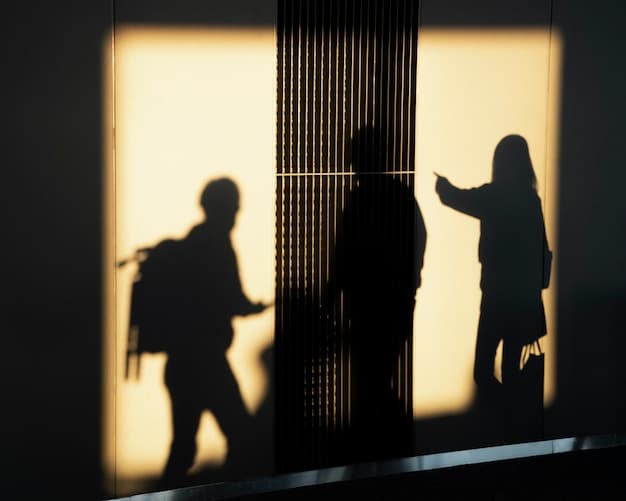How the Prison System Perpetuates Social Injustice: Alternatives for 2025

How does the prison system contribute to social injustice? Exploring Alternatives to Incarceration in 2025 requires analyzing systemic inequalities linked to race, class and exploring progressive solutions like restorative justice to address root causes of crime rather than relying solely on incarceration.
The American prison system is often viewed as a cornerstone of justice, but a closer examination reveals a complex web of issues. How does the prison system contribute to social injustice? Exploring Alternatives to Incarceration in 2025 is a critical question that demands our attention.
This article delves into the ways the prison system can exacerbate existing inequalities, perpetuate cycles of poverty and marginalization, and ultimately fail to rehabilitate individuals. By understanding these issues, we can explore innovative alternatives to incarceration and work towards a more just and equitable society.
Understanding the Prison System’s Role in Social Injustice
The prison system’s role in social injustice is a multifaceted issue deeply rooted in historical and systemic inequalities. To fully grasp the complexities, it’s essential to understand how the system can disproportionately affect marginalized communities and exacerbate existing social disparities.
Disproportionate Impact on Marginalized Communities
One of the most glaring examples of social injustice within the prison system is the disproportional representation of marginalized groups, particularly people of color. Statistics consistently show that Black and Hispanic individuals are incarcerated at significantly higher rates than their white counterparts, often for similar offenses.
Perpetuation of Cycles of Poverty and Marginalization
The prison system can also perpetuate cycles of poverty and marginalization by creating barriers to employment, housing, and education for individuals with criminal records. These barriers can make it difficult for formerly incarcerated people to reintegrate into society and lead productive lives, increasing the likelihood of recidivism.
- Limited Access to Opportunities: A criminal record can significantly limit access to employment, housing, and education, making it difficult for formerly incarcerated individuals to rebuild their lives.
- Stigma and Discrimination: Formerly incarcerated individuals often face stigma and discrimination, which can further hinder their ability to reintegrate into society.
- Financial Burdens: Incarceration can create financial burdens for individuals and their families, making it even harder to escape poverty.

In conclusion, the prison system can contribute to social injustice by disproportionately impacting marginalized communities and perpetuating cycles of poverty and marginalization. Addressing these issues requires a comprehensive approach that includes reforming sentencing laws, investing in community-based programs, and providing support for formerly incarcerated individuals.
Exploring the Root Causes of Mass Incarceration
Exploring the root causes of mass incarceration is paramount to understand how does the prison system contribute to social injustice? Exploring Alternatives to Incarceration in 2025. This multifaceted issue stems from various factors, including socioeconomic disparities, racial bias in the justice system, and the war on drugs.
Socioeconomic Disparities
Poverty, lack of educational opportunities, and limited access to resources can significantly increase the likelihood of involvement in the criminal justice system. Individuals from low-income communities often face greater challenges in accessing quality education, employment opportunities, and healthcare, making them more vulnerable to crime.
Racial Bias in the Justice System
Racial bias in the justice system is a deeply entrenched problem that contributes to mass incarceration. Studies have shown that people of color are more likely to be arrested, charged, convicted, and sentenced to harsher penalties than their white counterparts, even for similar offenses. This bias can be found at all stages of the criminal justice system, from policing to sentencing.
- Racial Profiling: People of color are disproportionately targeted by law enforcement, leading to higher arrest rates.
- Sentencing Disparities: Studies have revealed significant disparities in sentencing outcomes based on race, with people of color often receiving longer sentences.
- Implicit Bias: Unconscious biases can influence decision-making in the criminal justice system, leading to discriminatory outcomes.
The war on drugs, launched in the 1970s, has been a major driver of mass incarceration in the United States. Drug-related offenses account for a significant portion of the prison population, and the enforcement of drug laws has disproportionately impacted communities of color.
In closing, the root causes of mass incarceration are complex. By addressing these underlying issues, we can create a more just and equitable society.
The Impact of Incarceration on Families and Communities
Incarceration has a profound impact on families and communities, exacerbating social inequalities and creating long-term challenges. Understanding these impacts is crucial to understanding how does the prison system contribute to social injustice? Exploring Alternatives to Incarceration in 2025.
Strain on Family Relationships
Incarceration can place a significant strain on family relationships, particularly for children who have a parent in prison. Children with incarcerated parents are more likely to experience emotional distress, behavioral problems, and academic difficulties. The absence of a parent can also create financial instability and disrupt family dynamics.
Economic Hardship
Incarceration can lead to economic hardship for families and communities. The loss of income from an incarcerated family member can push families into poverty, and the costs associated with visiting and supporting an incarcerated loved one can further strain resources. Additionally, communities with high incarceration rates often experience economic decline due to the loss of productive workers and the drain on public resources.

In summary, incarceration has far-reaching consequences for families and communities, contributing to social injustice and hindering economic development. Addressing these impacts requires a comprehensive approach that includes providing support for families of incarcerated individuals and investing in community-based programs.
Alternatives to Incarceration: A Path to Social Justice in 2025
The quest to answer how does the prison system contribute to social injustice? Exploring Alternatives to Incarceration in 2025 leads us to consider alternative strategies. Alternatives to incarceration offer a more effective and just response to crime, focusing on rehabilitation, community restoration, and addressing the root causes of offending behavior.
Restorative Justice
Restorative justice is an approach to criminal justice that emphasizes repairing the harm caused by crime and involving all stakeholders in the process. Restorative justice practices typically involve bringing together victims, offenders, and community members to discuss the impact of the crime and develop a plan for making amends. These programs hold offenders accountable while promoting healing for victims.
Community-Based Programs
Community-based programs can provide support and resources to individuals at risk of offending, helping them address the underlying issues that contribute to criminal behavior. These programs may include:
- Mentoring Programs: Pairing at-risk youth with positive role models who can provide guidance and support.
- Job Training Programs: Equipping individuals with the skills and training they need to secure employment and become self-sufficient.
- Mental Health Services: Providing access to mental health treatment and counseling to address underlying issues that may contribute to criminal behavior.
- Substance Abuse Treatment: Offering evidence-based treatment for substance abuse to break the cycle of addiction and crime.
Investing in education and employment opportunities can help reduce crime rates by providing individuals with pathways to success and economic stability. By ensuring that everyone has access to quality education and job training, we can create a more level playing field and reduce the likelihood of involvement in the criminal justice system.
In closing, alternatives to incarceration offer a promising path to social justice by promoting rehabilitation, community restoration, and addressing the root causes of offending behavior.
Policy Changes Needed to Reform the Prison System by 2025
To truly address, how does the prison system contribute to social injustice? Exploring Alternatives to Incarceration in 2025 requires changes in policy. Reforming the prison system requires enacting comprehensive policy changes that address sentencing laws, drug policies, and reentry support.
Sentencing Reform
Sentencing reform is essential to reducing mass incarceration and addressing racial disparities in the justice system. Policies such as:
- Eliminate Mandatory Minimum Sentences: Mandatory minimum sentences limit judicial discretion and can lead to excessively harsh penalties.
- Reduce the Length of Sentences: Research suggests that excessively long sentences are not effective in deterring crime and can contribute to overcrowding and high costs..
- Expand the Use of Diversion Programs: Diversion programs allow individuals charged with non-violent offenses to avoid incarceration by participating in treatment, community service, or other programs.
Drug Policy Reform
Drug policy reform is necessary to reduce the number of people incarcerated for drug-related offenses and address the disproportionate impact of drug laws on communities of color. Policies such as:
- Decriminalize Drug Possession: Decriminalizing drug possession would reduce the number of people arrested and incarcerated for minor drug offenses.
- Invest in Treatment and Prevention: Investing in evidence-based treatment and prevention programs can help reduce drug use and addiction.
- End the War on Drugs: Ending the war on drugs would require a fundamental shift in drug policy, focusing on harm reduction, public health, and human rights.
Providing comprehensive reentry support to formerly incarcerated individuals is critical to helping them successfully reintegrate into society and reduce recidivism. This support may include:
- Housing Assistance: Providing stable housing to formerly incarcerated individuals can reduce their risk of homelessness and recidivism.
- Employment Assistance: Helping formerly incarcerated individuals find employment can improve their financial stability and reduce their likelihood of reoffending.
- Healthcare Access: Ensuring that formerly incarcerated individuals have access to healthcare, including mental health services and substance abuse treatment, can improve their overall well-being and reduce their risk of reoffending.
In conclusion, policy changes are essential to reforming the prison system and creating a more just and equitable society.
The Role of Technology in Prison Reform and Rehabilitation
Technology can play a significant role in prison reform and rehabilitation, offering innovative solutions to address challenges within the system. Understanding these roles is essential to understanding how does the prison system contribute to social injustice? Exploring Alternatives to Incarceration in 2025.
Educational Programs
Technology can enhance educational programs within prisons, providing incarcerated individuals with access to a wider range of learning resources and opportunities. Online courses, virtual reality simulations, and interactive educational platforms can make learning more engaging and accessible, helping incarcerated individuals develop new skills and knowledge.
Telehealth Services
Telehealth services can improve healthcare access for incarcerated individuals, particularly in rural or remote areas where access to medical professionals may be limited. Telehealth can also reduce the costs associated with transporting incarcerated individuals to off-site medical appointments, improving efficiency and resource allocation.
Technology can facilitate communication between incarcerated individuals and their families, helping to maintain and strengthen family relationships. Video conferencing, secure messaging platforms, and other communication technologies can bridge the physical distance between incarcerated individuals and their loved ones, promoting emotional well-being and reducing feelings of isolation.
In summary, technology has the potential to transform the prison system by enhancing education, improving healthcare access, and facilitating communication. By harnessing the power of technology, we can create a more rehabilitative and humane correctional system. As we look towards 2025, integrating such technologies is essential.
| Key Point | Brief Description |
|---|---|
| ⚖️ Systemic Inequality | Prisons disproportionately affect marginalized communities. |
| 👨👩👧👦 Family Impact | Incarceration strains relationships and creates economic hardship. |
| 🔄 Restorative Justice | Focuses on repairing harm through community involvement. |
| 💊 Drug Policy | Decriminalization and treatment over incarceration. |
Frequently Asked Questions
The prison system disproportionately affects marginalized communities, particularly people of color and those from low-income backgrounds, perpetuating cycles of poverty and inequality.
Alternatives include restorative justice programs, community-based rehabilitation, diversion programs, and investment in education and employment opportunities for at-risk individuals.
Policy changes could include sentencing reform, decriminalization of drug possession, investment in treatment and prevention, and comprehensive reentry support for formerly incarcerated people.
Technology can enhance educational programs, improve healthcare access through telehealth, and facilitate communication between incarcerated individuals and their families.
Poverty, lack of education, and limited access to resources increase the likelihood of involvement in the criminal justice system, which can lead to social injustice.
Conclusion
In reflecting on how does the prison system contribute to social injustice? Exploring Alternatives to Incarceration in 2025 , it’s evident that significant reforms are needed. The path forward involves not only acknowledging the systemic issues but also actively implementing alternative solutions that prioritize rehabilitation and community restoration.





